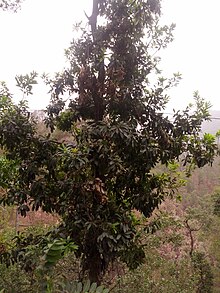bio.wikisort.org - Plant
Myrica esculenta is a tree or large shrub native to the hills of northern India, southern Bhutan and Nepal. Its common names include box myrtle, bayberry and kaphal. Its berries are edible and are consumed locally. It is the state fruit of the northern Indian state of Uttarakhand.
This article has multiple issues. Please help improve it or discuss these issues on the talk page. (Learn how and when to remove these template messages)
|
Habitat

Known locally as kaphal or kafal, Myrica esculenta is found in the hilly regions of northern India[1] and Nepal, especially in the regions of Garhwal and Kumaon of Uttarakhand, southern Bhutan and western Nepal especially at elevations of 900–1,800 m (3,000–6,000 ft).[2][unreliable source?] It is also found at elevations below 1,500 m (4,900 ft) in the midhills of Nepal. It is also found in Ziro, Arunachal Pradesh and some parts of Himachal Pradesh and Meghalaya.
Morphology

Myrica esculenta has a tree of medium height, about 6 to 8 m (20 to 26 ft). Bark is soft and brittle. Leaves are conjoint, 30–60 cm (1–2 ft) feet long that has leaflets in pairs of 6 to 9 and has a width of 19 mm (0.75 in). Flowers are of white color and are found in bunches. Fruit is a globose, succulent drupe, with a hard endocarp; diameter 1.1–1.3 cm (0.43–0.51 in); average mass 670 mg (10.3 gr). Seeds are triangular in shape and are astringent in taste.
According to Ayurveda, it has two varieties based on the color of flower: Shweta (white) and Rakta (red).[2]
Chemical constituents
The bark is yellow and contains the chemical substances myricetin, myricitrin and glycosides.[2] Leaves of the plant also contain flavone-4'-hydroxy-3',5,5'-trimethoxy-7-O-β-I-D-glucopyranosy)(1→4)-α-L-rhamnopyranoside; flavone-3',4'-dihydroxy-6-methoxy-7-O-α-L-rhamnopyranoside; β-sitosterol; β-sitosterol-β-D-glucopyranoside and quercetin.[3]
References
- "Basanti and the Kosi: How one woman revitalized a watershed in Uttarakhand". www.indiawaterportal.org. Retrieved 2020-07-07.
- "Myrica esculenta". ayushveda.com. Archived from the original on 2016-12-16. Retrieved 2011-01-26.
- Bamola A, Semwal DK, Semwal S, Rawat U. Flavonoid glycosides from Myrica esculenta leaves. Journal of the Indian Chemical Society. 2009;86(5):535-6. Archived 2015-07-23 at the Wayback Machine
Другой контент может иметь иную лицензию. Перед использованием материалов сайта WikiSort.org внимательно изучите правила лицензирования конкретных элементов наполнения сайта.
WikiSort.org - проект по пересортировке и дополнению контента Википедии
